HORMANN FSM-2 Radio Transmitter Module Instruction Manual
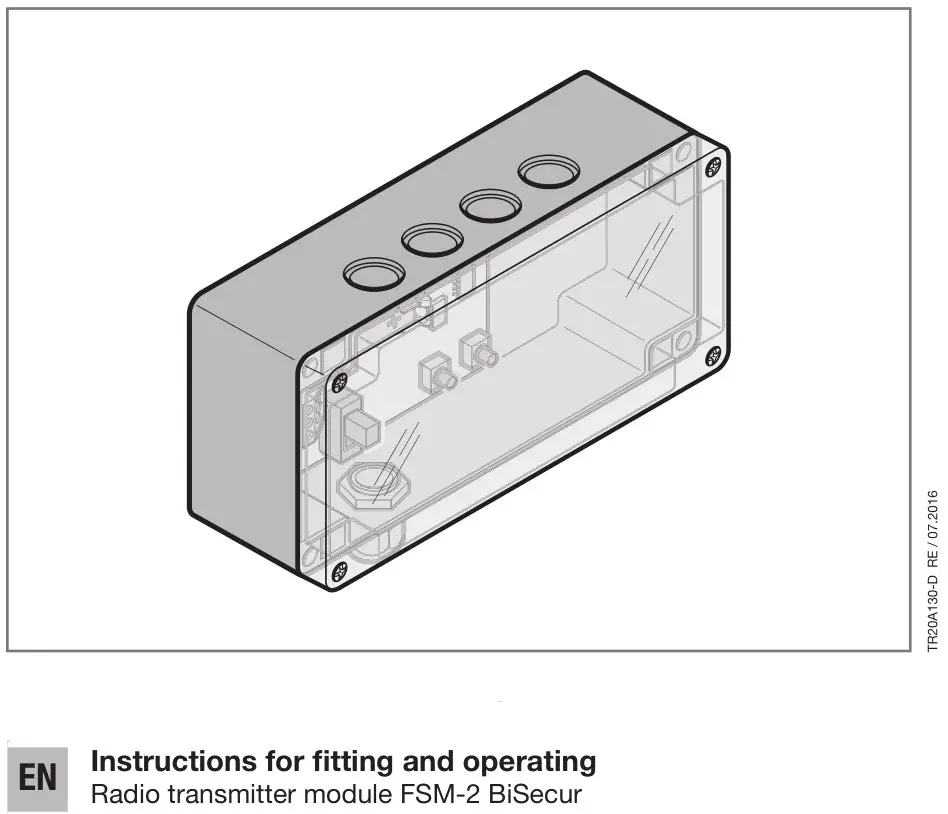
Dissemination as well as duplication of this document and the use and communication of its content are prohibited unless explicitly permitted. Noncompliance will result in damage compensation obligations. All rights reserved in the event of patent, utility model or design model registration. Subject to changes.
Dear Customer,
We thank you for choosing a quality product from our company.
1. About these instructions
Read through all of the instructions carefully, as they contain important information about the product. Pay attention to and follow the instructions provided, particularly the safety instructions and warnings.
Please keep these instructions in a safe place and make sure that they are available to all users at all times.
2. Safety instructions
2.1 Intended use
The radio transmitter module FSM-2 BiSecur is a uni-directional transmitter with two channels for door control radio receivers. It can be operated with both the BiSecur radio and the fixed code 868 MHz.
Other types of application are prohibited. The manufacturer is not liable for damage caused by improper use or incorrect operation.
2.2 Safety information on operation of the radio transmitter module
![]() WARNING
WARNING
Danger of injury during door travel
Persons may be injured by door travel if the radio transmitter module is actuated.
- Make sure that the radio transmitter module is only used by people who have been instructed on how the remote-control door functions!
- If the door has only one safety feature, only operate the radio transmitter module if you are within sight of the door!
- Only drive or pass through remote-control door systems if the door is in the Open end-of-travel position!
- Never stand in the door’s area of travel.
![]() CAUTION
CAUTION
Danger of injuries due to unintended door travel
- See warning in section 6.1
NOTES:
- If there is no separate garage entrance, perform all programming changes and extensions of radio systems from inside the garage.
- After programming or extending the radio system, perform a function test.
- Only use original components when putting the radio system into service or extending it.
- Local conditions may affect the range of the radio system.
- When used at the same time, GSM 900 mobile phones can affect the range.
3. Scope of delivery
- Radio transmitter module FSM-2 BiSecur
- 1 × 1.5 V battery, type AAA (LR03)
- Fixing material
- Operating instructions
4. Function
The impulse from the control elements connected at the two inputs is sent to the door control receiver as a radio signal. The door can thus be opened and closed in impulse operation.
5. Description of the radio transmitter module FSM-2 BiSecur
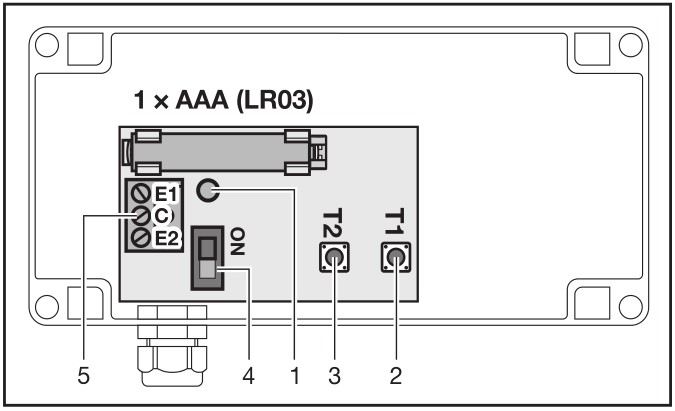
1 LED, bi-colour
2 Transmitter button T1 (channel 1)
3 Transmitter button T2 (channel 2)
4 The switch must be on the ON position
5 Battery housing
6 Button connection
5.1. Fitting

The housing of the radio transmitter module is fixed as shown in the figure. The cable fixings must face downwards.
5.2 Connection of control elements
The radio transmitter module can be actuated via an external push button. If it is connected at input E1, a door can open and close in impulse operation.

5.2.2 Key switches
The radio transmitter module can be actuated via an external key switch. If connected at input E1 and E2, two garage doors can be opened and closed in impulse operation.

5.2.3 Pull cord switch
The radio transmitter module can be actuated by a pull cord switch fastened to a cantilever arm. If connected at input E1, a door can open and close in impulse operation.
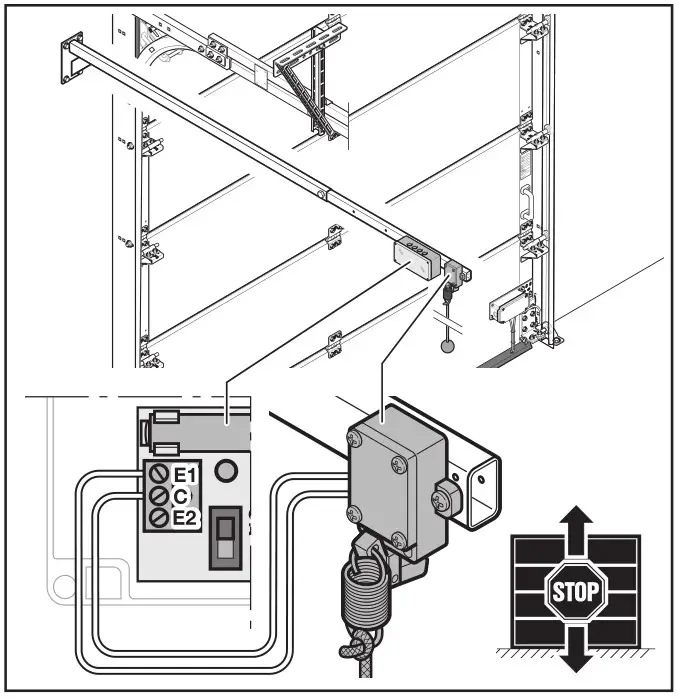
5.3 Malfunctions
5.3.1 Radio module
- Battery test:
Press the T1 button. The LED must be illuminated in blue for approx. 2 seconds. - The connection cable to external switches must be connected at positions “E1” and “C”.
- To ensure correct function, the sliding switch must be set to ON on the left.
5.4 Teaching in the receiver
The receiver must be taught in to match the radio code of the radio transmitter module in accordance with its instructions.
6 The radio transmitter module
NOTE:
The radio codes are sent via the switches connected at inputs E1 or E2. These correspond to the transmitter buttons T1 or T2 on the radio module circuit board. The inputs E1 and E2 can be switched to OFF using the On / Off switch.
If the radio code for the taught-in transmitter button was copied from another hand transmitter beforehand, the transmitter button must be pressed a second time during initial start-up.
Each transmitter button is assigned to a radio code. Press the transmitter button whose radio code you want to transmit.
– The radio code is transmitted and the LED is illuminated blue for 2 seconds.
NOTE: If the battery is almost empty, the LED flashes red twice
a. before transmitting the radio code.
▶ The battery should be replaced soon.
a. and the radio code is not transmitted.
▶ The battery must be replaced immediately.
6.1 Learning and inheriting / transmitting a radio code
![]() CAUTION
CAUTION
Danger of injuries due to unintended door travel
Unintended door travel may occur while teaching in the radio system.
- Make sure no persons or objects are in the door’s area of travel when teaching in the radio system.
6.2 Teaching in a radio code
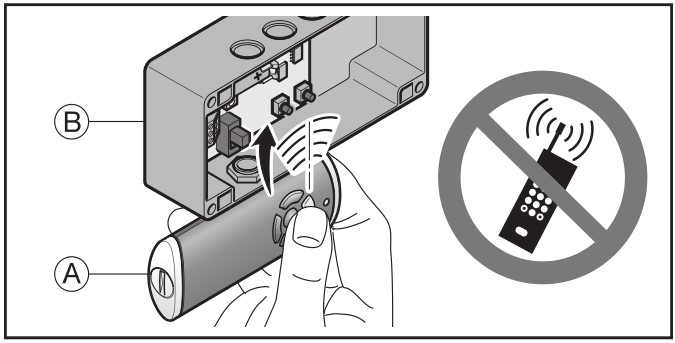
- Press the hand transmitter button on hand transmitter A, whose radio code is to be inherited, and keep it pressed.
- The radio code is transmitted and the LED is illuminated blue for 2 seconds then goes out.
- After 5 seconds, the LED flashes alternately red and blue, the radio transmitter module transmits the radio code.
- Hold the hand transmitter to the right of the radio transmitter module.
- Press the transmitter button (T1 / T2) of the radio transmitter module to which the new radio code is to be allocated, and keep it pressed.
- The LED will flash slowly in blue.
- If the radio code is recognised, the LED flashes quickly in blue.
- After 2 seconds, the LED goes out.
NOTE: You have 15 seconds to inherit / transmit the code. The process must be repeated if the radio code is not successfully inherited / transmitted within this time.
6.3 Mixed operation / BiSecur and fixed code 868 MHz
If the BiSecur radio has been set, mixed operation is possible, i.e. existing hand transmitters with an 868 MHz fixed code (grey hand transmitters with blue buttons or the device designation HSD2-868) can be taught in from the radio transmitter module control.
6.4 Reset
Each transmitter button is assigned to a new radio code by means of the following steps.
- Open the radio transmitter module housing and remove the batteries for 10 seconds.
- Press transmitter button T1 and keep it pressed.
- Reinsert the battery.
- The LED slowly flashes in blue for 4 seconds.
- The LED flashes rapidly in blue for 2 seconds.
- The LED is illuminated blue for a long time.
- Release the transmitter button.
All radio codes are newly assigned. - Close the radio transmitter module housing.
NOTE: If transmitter button T1 is released prematurely, no new radio codes are assigned.
6.5 Set the fixed code 868 MHz
If transmitter button T1 remains pressed right after a device reset, the fixed code 868 MHz will be activated.
- The LED slowly flashes in red for 4 seconds.
- The LED flashes rapidly in red for 2 seconds.
- The LED is illuminated red for a long time.
All radio codes are newly assigned.
NOTE: If transmitter button T1 is released prematurely, the BiSecur radio will remain active.
Further information about operating the radio transmitter module with the fixed code 868 MHz can be found on the Internet at www.hoermann.com
6.6 LED display
NOTE: In BiSecur operation, the LED is illuminated in blue and red and in fixed code 868 MHz operation the LED is only illuminated in red.
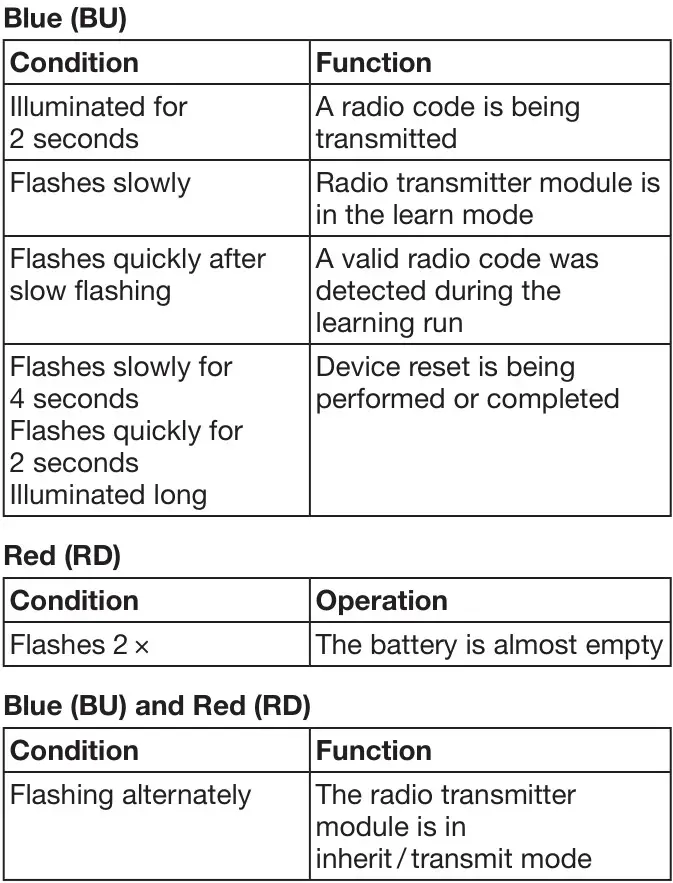
7 Disposal
![]()
Electrical and electronic devices, as well as batteries, may not be disposed of in household rubbish. They must be returned to the appropriate recycling facilities.
8. Technical data
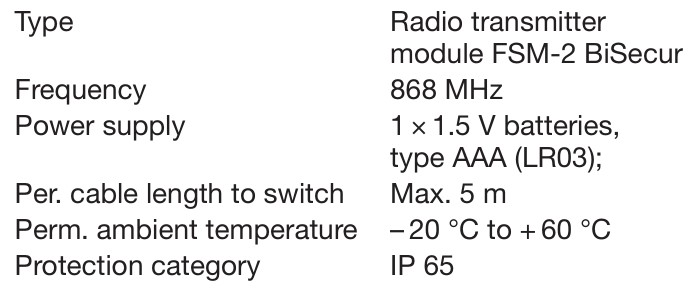
9. EC Declaration of Conformity
As defined in the Radio Equipment Directive (RED) 2014/53/EU
Herewith the
Company
Hörmann KG Verkaufsgesellschaft
Upheider Weg 94-98
D-33803 Steinhagen
declares that this
device
Radio transmitter module for operators
Article designation FSM-2 BiSecur
Type designation FSM2-868-BS
based on its design and style in the marketed version is in accordance with the basic requirements and other relevant requirements of the Radio Equipment Directive (RED) 2014/53/EU.
Any modification made to the devices without our express permission and approval shall render this declaration null and void.
Applied and consulted standards and specifications:
EN 60950-1
EN 300 220-1
EN 300 220-2
EN 301 489-1
EN 301 489-3
This device may be operated in all EU nations,
Norway, Switzerland and other countries.
Steinhagen, 13.06.2016

ppa. Axel Becker, Management
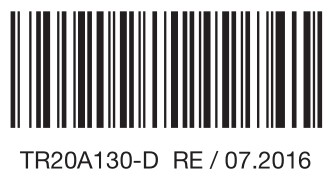
HÖRMANN KG Verkaufsgesellschaft
Upheider Weg 94-98
D-33803 Steinhagen
www.hoermann.com
Documents / Resources
 |
HORMANN FSM-2 Radio Transmitter Module [pdf] Instruction Manual TR20A130-D, RE - 07.2016, FSM-2 Radio Transmitter Module, FSM-2, Radio Transmitter Module, Transmitter Module, Module |